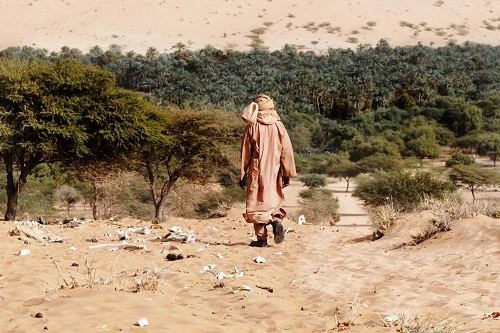IFRC photo
By
Tom Arms
Walls are generally built to keep people out. Trump’s big beautiful wall, Hungary’s anti-refugee wall, the Great Wall of China, Hadrian’s Wall and every castle wall built before, during and after the medieval period.
There are exceptions to this rule. The Berlin Wall was built to keep people in, as is every prison wall ever constructed.
But in Africa a wall with a difference is literally sprouting. It has been dubbed “The Great Green Wall of Africa.” It is neither holding people in nor keeping them out. It is holding at bay the sands of the Sahara desert and helping people to stay in Africa.
They started planting the Great Green Wall of Africa ten years ago. The wall is in fact a six mile wide strip of millions of Acacia trees which will eventually stretch 4,800 miles across the southern edge of the Sahara and through 11 countries from Senegal on the West coast to Djibouti on the Red Sea. That is about half the length of Trump’s proposed wall along the US-Mexican border and about 600 miles short of the length of the Great Wall of China.
Its purpose is to battle the effects of climate change in Africa. Over the last half century 60 acres a minute have been lost to desertification as the Sahara marches south.
This means that if you are an African farmer in Somalia, the Sudan, Chad, Senegal or many other African countries, there is a good chance that you have, or will lose your livelihood to the shifting sands of climate change. With no livelihood you either starve, join Boko Haram or its like, flee to overcrowded cities such as Nairobi and Mombasa or risk your life trying to illegally immigrate to Europe or America.
By 2020, if nothing is done, it is estimated that desertification will be the primary cause of 60 million people attempting to migrate out of Africa.
Monique Barbut, the executive secretary of the UN Convention to Combat Desertification, said: “There is an emergency, and I have a feeling that people do not really get it. Most of the people who talk about migration – the press, the TV and all that – they always either say it’s because there’s a war or because they are so poor they are migrating. But why do you have wars? Why do you have economic distress which makes you migrate? It’s rare that people unearth the real roots of that question.”
So far 4.5million acres of sturdy acacia trees have been planted in Ethiopia, 12.5 million in Algeria and 6,000 in Sudan. Altogether an estimated 11.4 million acacia trees have been planted since 2007. The Great Green Wall is planned to be completed by 2030 and is projected to provide food security for 25 million people and create 10 million small farms.
The cost is estimated at $8 billion. The project is being funded primarily by the European Union, UN agencies and the World Bank and coordinated by the African Union.
The acacia trees are not only holding back the sand but are actually helping to reclaim the desert. They produce a lovely flower and the Australian aborigines grind the seeds for an edible—if not very tasty—paste. But the reason they are being planted across Africa is that they grow fast and deep.
In doing so they prevent the wind from blowing away the top soil. They have been so effective at this task that in Senegal farmers have pushed back the sand and planted vegetable crops under and behind the trees. The green border along the Sahara’s southern edge is becoming visible from space.
The concept for the Great Green Wall has taken years to come to fruition. It was first mooted in 1952 by the British colonial forester Richard St. Barbe Baker. It lay dormant until 2002 when it was pulled out of the archives at a Conference to Combat Desertification and Drought. It took, however, another ten years for the first tree to be planted.
But since then the wall has sprouted like a fast-growing weed. And it is already helping hundreds of thousands of Africans to stay close to their roots.
Tom Arms is the editor of LookAheadnews.com. Sign up now for the weekly diary of world news events.
LookAhead Radio World Report for week commencing 16 October 2017:
Tom Arms
I am a journalist, entrepreneur and historian with extensive experience in print, web and broadcast journalism. I started as a diplomatic correspondent, wrote several books (The Falklands Crisis, World Elections On File and the Encyclopedia of the Cold War), and then in 1987 started my own business (Future Events News Service, www.fensinformation.com) which over 25 years established itself as the world and UK media’s diary. Our strapline was: “We set the world’s news agenda.” I sold FENS in December 2012 but retained the exclusive broadcast rights to all of FENS data. To exploit these rights I set up LookAhead TV which produces unique programmes which “Broadcasts Tomorrow Today” so that viewers can “Plan to Participate.” LookAhead has appeared regularly on Vox Africa, Radio Tatras International, The Conversation and Voice of Africa Radio.
In addition to being a syndicated broadcaster and columnist on global affairs, Tom is also available for speaking engagements and can be contacted on Twitter, Linkedin and email: [email protected].



This is very interesting! Are there any monitoring activities going on to assess survival rates of the trees, soil erosion rates in planted and unplanted areas, soil fertility etc? I think this would be a valuable step. It would also be useful to explore the use of indigenous tree species adapted to drier climates for this green wall. Thank you for this essay.